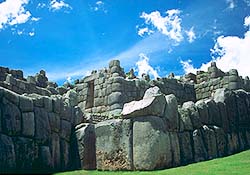A - A Online
Inca
The Inca were the rulers of the largest native empire of the Americas. Near the end of the 14th century the empire began to expand from its initial base in the Cuzco region of the southern Andes mountains of South America. It ended abruptly with the Spanish invasion led by Francisco Pizarro in 1532. At the time of its demise, the empire controlled an estimated 12 million people in much of what is now Peru and Ecuador as well as in large parts of Chile, Bolivia, and Argentina.
 |
The Incas called their land "Tawantinsuyu", which in Quechua, the Inca language, means the "four parts." A land of markedly diverse terrain and climate, it included a long coastal desert strip, broken by rich irrigated valleys; the high peaks and deep fertile valleys of the Andes; and the mountainous edges of the tropical forest to the east. The term Inca refers to the ruler himself as well as to the people of the valley of Cuzco, the capital of the empire. It is sometimes used to refer to all of the peoples included within Tawantinsuyu, but this is not strictly correct. Most of the dozens of smaller local kingdoms retained their identities even though politically and economically subject to the Incas. Quechua was the official language and was spoken in most of the realm by the time the Spanish arrived, but at least 20 local languages persisted in various parts of the empire.
 |
Architecture
The Incas developed a highly functional style of public architecture distinguished above all by its superior engineering techniques and fine stone masonry. The plan of their cities was based on a system of broad avenues intersected by smaller streets that converge on an open square lined by state buildings and temples. Structures were usually single-storied, with perfectly bonded joints of cut stone, although adobe bricks and plaster were commonly used in the coastal lowlands.
 |
For building large monuments such as the great fortress of Sacschuaman near Cuzco, massive polygonal blocks were fitted together with extraordinary precision. In mountainous regions, as at the spectacularly situated Andean citadel of Machu Picchu, Inca architecture often reflects ingenious adaptations to the surrounding land forms.
 |
Religion
The state religion centered on the worship of the Sun. The Inca emperors were believed descended from the Sun god and were worshiped as divine beings. Gold, the symbol of the Sun god, was extensively mined for use by the rulers and members of the elite, not as a means of exchange but principally for decorative and ritual purposes. Religion permeated the entire political structure. From the Temple of the Sun in the center of Cuzco imaginary lines ran to shrines in and around the city that were identified with different social groups. Religious practices included the consultation of oracles, the offering of sacrifices, religious trances, and public confessions. An annual cycle of religious festivals was regulated by the extremely accurate Inca calendar, as was the agricultural year. In this and other respects, Inca culture strongly resembled certain cultures of Mesoamerica, such as the Aztecs and the Maya.
|see map| |Machu Picchu| |Cuzco| |Inca Art|
|MAYA|AZTEC|INCA|TOLTEC|OLMEC|MIXTEC|ZAPOTEC| NAZCA|EASTER ISLAND|
| FEEDBACK| SUSCRIBE| MAIL| FIELD NOTES| NEWS| SITE MAP|HOME|